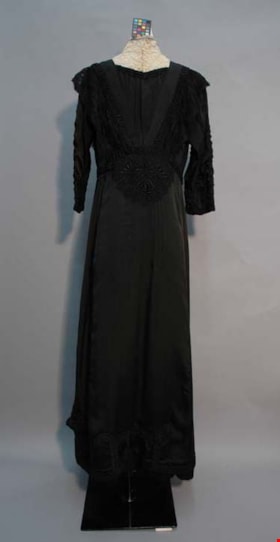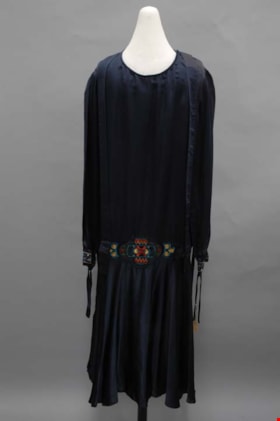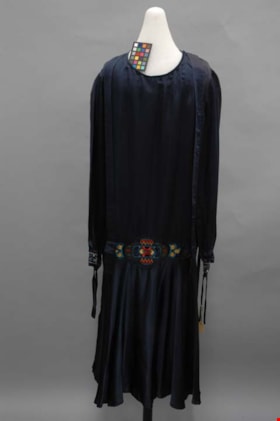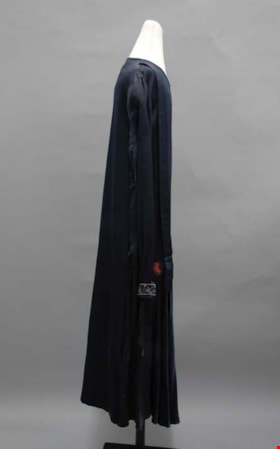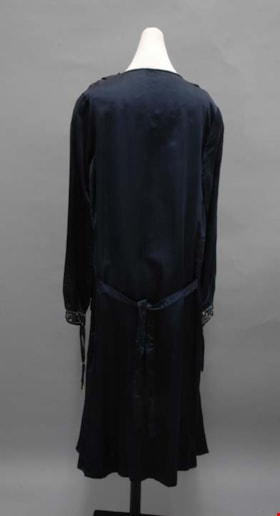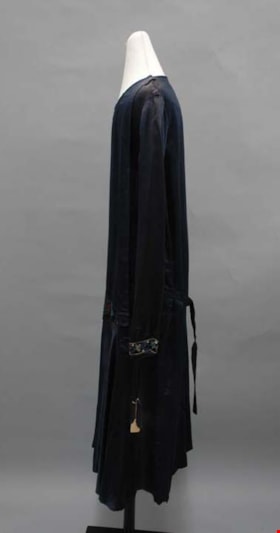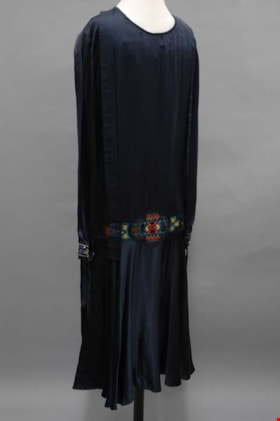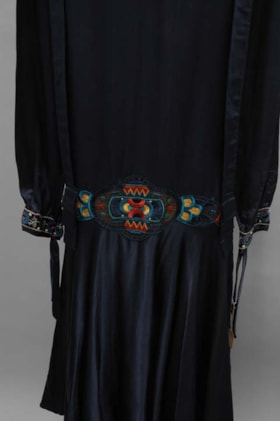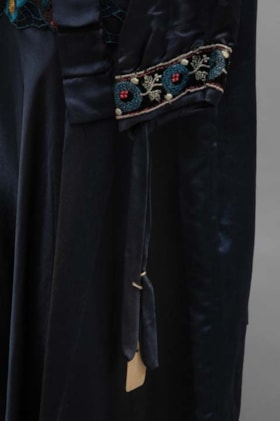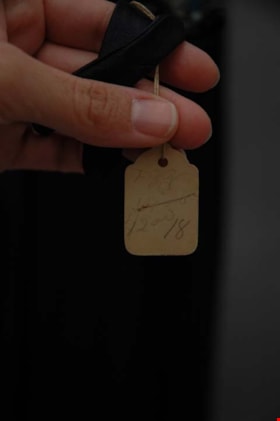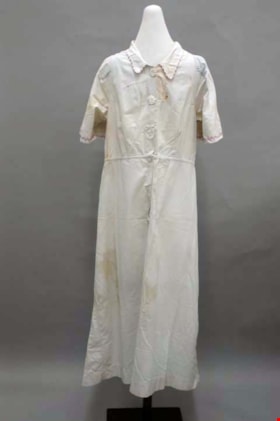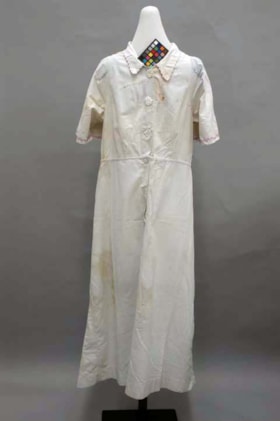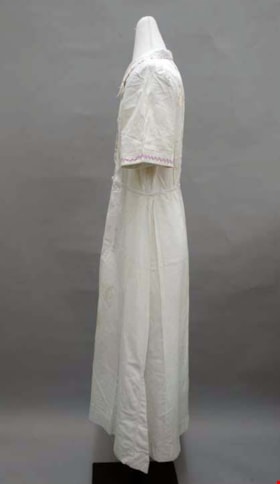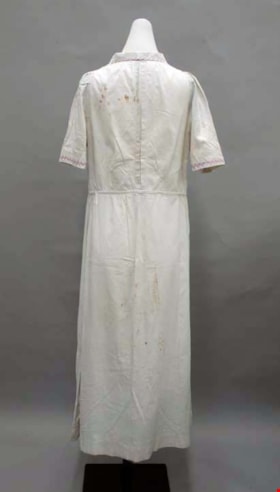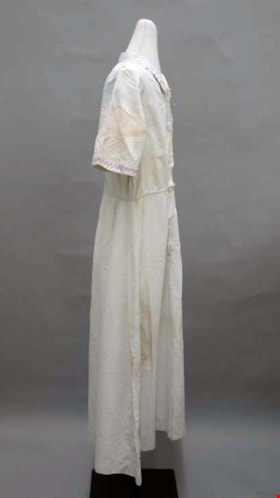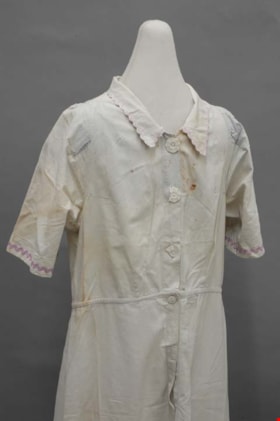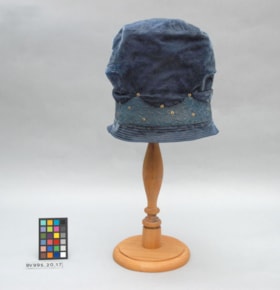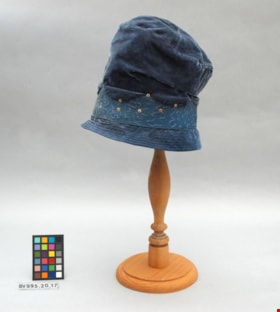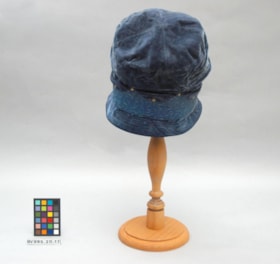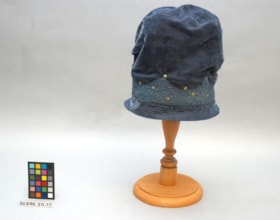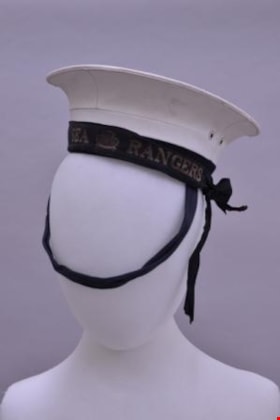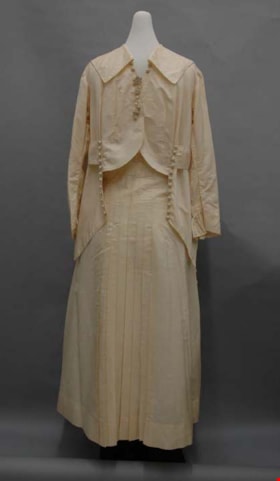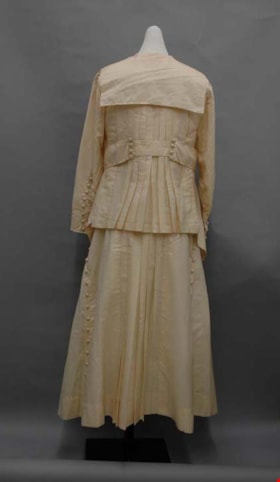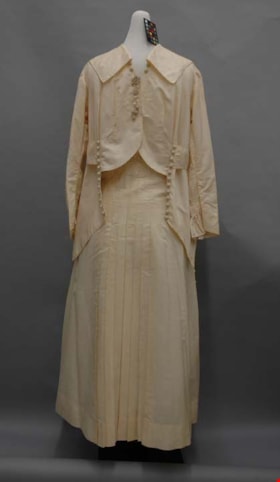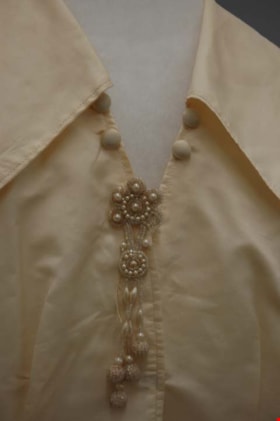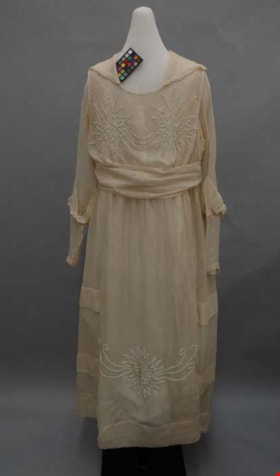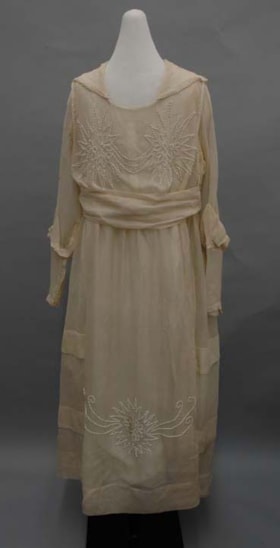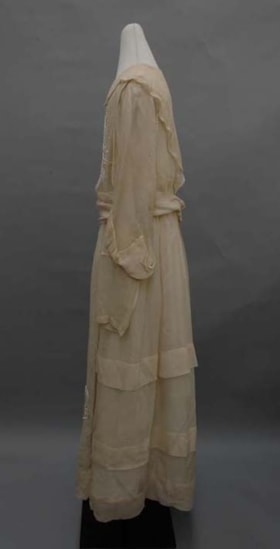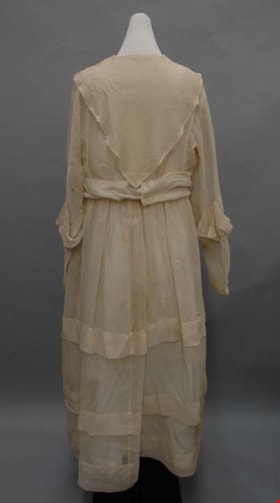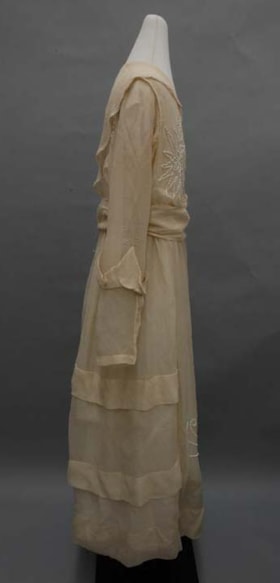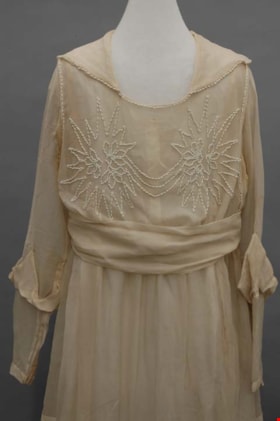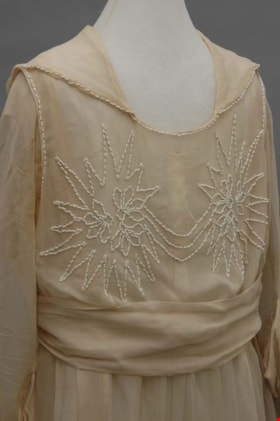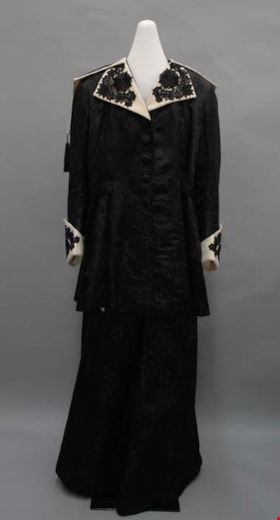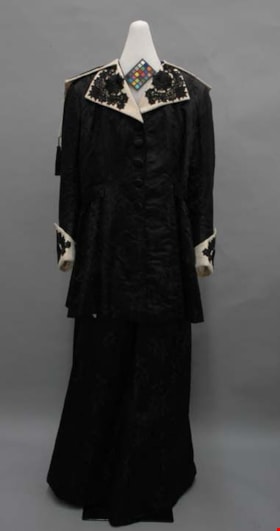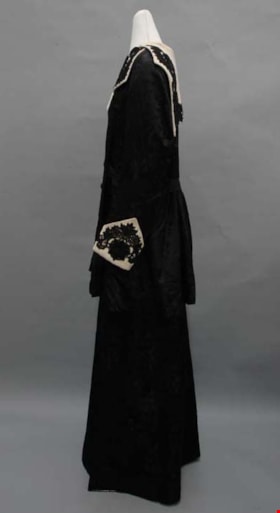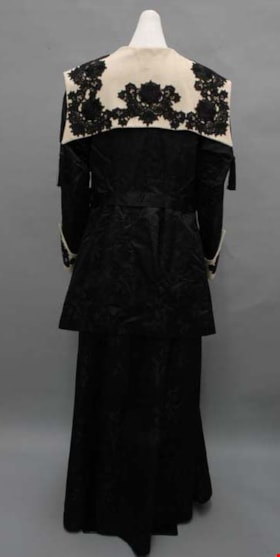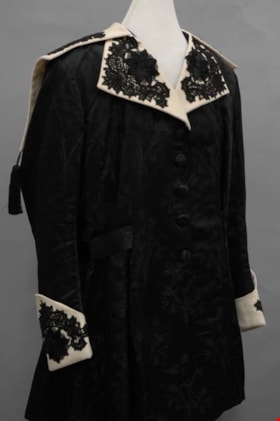Narrow Results By
bodice and underskirt
https://search.heritageburnaby.ca/link/museumartifact25323
- Repository
- Burnaby Village Museum
- Accession Code
- HV975.55.2
- Description
- Bodice and underskirt, c.1895. Black wool bodice, black silk taffeta underskirt. Black satin trim, leg o' mutton sleeves, standing collar, embroidery on bodice. At the back of the standing collar there is a bow in satin ribbon. At the front of the bodice, there is a section of gathered fabric at either side of the centre front closure decorated with black floral embroidery. At the edge of the right front there is a pleated ruffle of satin ribbon. The embroidered section is also bordered by a satin ribbon on each side. The sleeves are heavily gathered at the sleeve cap, creating large leg o' mutton sleeves. They taper down to the wrists, which also have some of the same embroidery as the centre front bodice, just before the cuffs. The cuffs do not have an opening. At the back of the bodice, there is no decoration. The waistband consists of a twisted satin ribbon with a bow at centre front and centre back. Inside, the bodice is lined with beige linen. It has eight bones one the front and back. The underskirt is made of undecorated lightweight silk taffeta, and may be a petticoat instead of an underskirt. It has a grosgrain waistband with built in stays, five gores, and one dart for shaping. It does not close at its regular opening, but rather folds over to close via a snap further along the waistband.
- Subjects
- Clothing
- Clothing - Costumes
Images
wedding dress
https://search.heritageburnaby.ca/link/museumartifact30795
- Repository
- Burnaby Village Museum
- Accession Code
- HV972.5.5
- Description
- Wedding dress or perhaps a regular dress once worn as a wedding dress, c.1910. Made from a heavyweight beige cotton. Embroidered net collar and yoke, and embroidered front panel. Princess seams and pin tucks form a flared, pleated skirt. Long sleeves, and pink edging on some seams. The fabric is a heavy, somewhat glossy cotton that makes the dress seem more like an item to be for everyday activities instead of as a wedding dress. Its silhouette is distinctive of the late Edwardian period, with its higher waist, close natural shaping, and somewhat flared ankle length skirt. In the bodice, two pleats on each side front create fullness. The collar and yoke are made of netting, lined with white silk, edged with pink ribbon, and embroidered in an undulating pattern of lines. There are two small brown buttons (previously covered in pink fabric) on either side of the net yoke. Two pin tucks run the length of either side of the back bodice. The sleeves are full length, with gathered caps and nine 1cm pin tucks down the length of each. There are two false previously pink buttons on each cuff, which are also edged in pink. A two inch waistband extends from the centre front panel to the back. There is a previously pink button on each front corner, and the whole band is edged in ribbon. The top left button is missing. It has a pink lining on the inside. The skirt is made up of six gores, not including the centre front panel. The left and right side of the skirt each have eight pleats, released halfway down with pin tucks. On the centre back, a pin tuck on either side of the closure released a large inverted box pleat. A false hem is hand sewn at the bottom, and machine sewn at its top. The dress closes with hooks and eyes along the centre back, from the top of the collar to a third of the way down the skirt. On the centre front, there is a panel that extends from the shoulders to the hem, using princess seaming. It is edged along its seams with pink ribbon. It is covered in in a hand-applied ribbon of couched thread, as well as some embroidered french knot flowers down the centre front line. The dress is mainly machine sewn. Seams are finished by whip-stitching the seam allowances together when the selvedge is not used.
- Subjects
- Clothing
- Clothing - Costumes
Images
bodice
https://search.heritageburnaby.ca/link/museumartifact29996
- Repository
- Burnaby Village Museum
- Accession Code
- HV973.73.155
- Description
- Bodice, c.1870-1875. Olive green silk shot with purple, with purple brocade, ribbon, and cotton twill piping. Buttons down centre front, high neck, long sleeves, cuirass design. The stand collar is fairly small, with a close neckline. It is made of a mauve silk brocade with a pattern of tiny purple ovals. There is a panel of this fabric that goes down the centre front and centre back from the shoulders to the hem, separated from the main fabric by purple twill piping. At the centre front, the bodice also closes from top to bottom with twelve buttons covered in mauve fabric with a brocade flower and a hook and eye at the collar. At the centre back there is another line of purple piping, and there is a self fabric covered button on each outside line of piping at the waist level. The rest of the front and back bodice is made of the olive and purple shot silk, with two darts at each side front. The armscyes are sewn with purple piping, and the sleeves are made in the olive and purple shot silk. At the cuffs, there is a band edged in purple piping and trimmed with a mauve ribbon bow. Beneath this there are two tiers of pleated ruffle in the mauve brocade. At the hem of the bodice, there is a double row of purple piping. The bodice is lined in brown linen. It has short bones in each front dart, and one in each side seam. The section below the waist is lined in purple china silk.
- Subjects
- Clothing
- Clothing - Costumes
Images
dress
https://search.heritageburnaby.ca/link/museumartifact9403
- Repository
- Burnaby Village Museum
- Accession Code
- BV985.1814.1
- Description
- Dress, c.1925-1929. Beige floral cotton rayon blend, with blue silk yoke and sleeves. Knee length skirt, dropped waist, straight shape with half length bishop sleeves. The front of this dress has a blue silk yoke with attached collar, edged in pink ribbon. The yoke opens up with a V-neck, and has ten pink and gold buttons down the centre front. There is also one button directly under the left side of the collar, with a loop closure on the right. The rest of the bodice is beige cotton-rayon with a pattern of blue and red flowers, and it is unshaped. The bishop sleeves are half length, with the fabric changing to blue silk two thirds of the way down. It closes at the cuff with a fabric tie. At the end of the bodice yoke is a slightly dropped waistband of blue silk, and below this hangs two small triangle shapes edged in pink ribbon. The skirt is made of the blue floral fabric. It is cut as a straight tube, but there are three box pleats on the front to add some volume.
- Subjects
- Clothing
- Clothing - Costumes
Images
dress
https://search.heritageburnaby.ca/link/museumartifact32391
- Repository
- Burnaby Village Museum
- Accession Code
- HV972.114.1
- Description
- Dress, c.1884. Beige silk taffeta and ivory silk floral brocade, mauve trim. Bodice with low square neck, half length sleeves with ruffle cuffs. Skirt with train, drapery around hips, ruffles down front. Trousseau for wedding. The bodice is made of beige taffeta, lined with white silk twill sewn together with the main fabric. It has a low square neckline. Its half length sleeves are attached at the armscye with a corded seam, and at the cuff they have a large pleated ruffle in mauve silk taffeta lined with the same fabric as the skirt. Besides this, there is no decoration on the bodice (it is noted in the accession file that the trim is missing from the bodice). Shaping comes from two darts on either side front and six panels in the back. There is boning in each dart and one in each side seam. The bodice extends to the hips, cinching in at the waist. At the centre back of the waist there is a white silk ribbon the extends to the left, and may have also been on the right as well originally. It closes at centre front with hooks and eyes. The skirt is made of ivory brocade with a sparse pattern of small pink floral bouquets. It has a grosgrain waistband that closes with two hooks and eyes at centre back. The opening in the skirt below does not have any closures. There are six gores, all sewn together with the cotton voile lining except for the centre front seam. At the top of the skirt there is a section of drapery (also lined in cotton voile) that circles around the hips to the side backs. It is ruched at centre front in three vertical lines. Under the drapery on the right side, there is a pocket with a cotton twill bag inserted into the seam. The skirt is heavily pleated at the back, where there is also a long train. The front or the skirt, extending to the front two gores, has a thin band of mauve ribbon right under the top drapery. Regularly spaced down the front of the skirt there are two rows of mauve pleated ruffles, like those on the bodice cuffs. At the hem there is another pleated ruffle that runs its whole length, made of the main dress fabric. The bodice is entirely hand sewn. The straight seams on the skirt are sewn with a chain stitch machine, and the rest is done by hand. The seams are finished with whip-stitching where the selvedge is not used.
- Object History
- This dress was part of Bella Rebecca Max's trousseau. She married Louis Levy in 1880 in Ontario.
- Subjects
- Clothing
- Clothing - Costumes
Images
evening bodice
https://search.heritageburnaby.ca/link/museumartifact30792
- Repository
- Burnaby Village Museum
- Accession Code
- HV972.5.2
- Description
- Evening bodice, c.1860-1865. Silk taffeta ikat design, cream background with purple stripes and flowers. Low round neck, short puff sleeves, round natural waist length. The low round neckline is bordered by a thin purple velvet ribbon, and the neck edge is corded. The short puff sleeves rest low on the shoulders with corded seams, and they are gathered into a cuff trimmed with the same velvet ribbon. The front of the bodice has a centre panel and two side panels with top stitched seams that run in an upwards arc from the underarms to either side of the centre front. The back of the bodice has two darts on either side, and a centre back closure of hooks and thread eyes. Inside, the bodice is lined in white linen. It has boning in each side seam, as well as each back dart. At the bottom, there is a waist band of the same fabric. The bodice fabric print consists of a cream background with vertical purple stripes separated by vertical floral zig-zags. The zig-zags are connected the green stems, and at each corner there is a bud in a pattern of pink, blue, and purple.
- Subjects
- Clothing
- Clothing - Costumes
Images
wedding dress
https://search.heritageburnaby.ca/link/museumartifact4503
- Repository
- Burnaby Village Museum
- Accession Code
- BV988.71.1
- Description
- Wedding dress, c.1909-1910. White cotton crepe with hand embroidery. Short bodice with pin tucks, slight pouf, and three quarter sleeves. Pleated ankle length column skirt. The bodice has a small lace edged V neck, and three pin tucks on each shoulder. Two of the pin tucks angle inwards and continue to the waistline. Between the tucks the bodice is covered with hand worked floral and ribbon themed embroidery. It is gathered at the waistband, creating a slight puff reminiscent of the recently out of fashion pouter pigeon bodice. The back of the bodice has three vertical pin tucks that extend from the shoulder to the waistband on either side of the centre back button closure, with thread covered buttons. There is a slight gather between the pin tucks and side back seams, from the panel under each arm. The sleeves are three quarters in length. They have turned up cuffs topped with embroidery and edged with the same lace as seen on the collar. The skirt has a sailor front opening with six thread covered buttons on either side of a centre front panel. Just past hip level, there are two accordion pleats on either side of the panel. There is a gore on each side and one on the back that flare out slightly; each has the floral and ribbon embroidery. On the back gore, there is a pleat on either side at calf level. The hem is ankle length.
- Object History
- From donor: "This was the wedding dress of my sister-in-law's mother, worn about 1905. They came from Maine. Made of cotton, hand embroidery, a typical "country-type" wedding gown of the period. It was given to me by my sister-in-law and I am only too glad to have it find such a welcoming spot in B.C.!"
- Subjects
- Clothing
- Clothing - Costumes
Images
bodice
https://search.heritageburnaby.ca/link/museumartifact27027
- Repository
- Burnaby Village Museum
- Accession Code
- HV974.69.22
- Description
- Bodice, c.1902-1903. Black net with silver thread, black velvet, and and black embroidery, white silk under layer. Three quarter length sleeves, high collar, pouter pigeon. The high standing collar has four stays to keep it upright. It has an under-layer of white silk, and an over-layer of embroidered net like the rest of the bodice. At the neckline and shoulders, the net is gathered and pleated, as well as at the waistband, so if will puff out. At the centre front of the bodice there is a floral motif in black thread, and that is surrounded by tendrils of silver metal thread embroidery, with loops filled in with black velvet. At the back of the bodice, there is silver and velvet embroidery at the top near the shoulders. Beneath, there is floral embroidery in black thread. The embroidered net on the sleeves is gathered at the top and sides of the armscye, and at the cuff. There are two ball buttons at the cuff covered in metallic tulle, and the cuff itself has two layers of gathered net ruffle; the outside layer is black and the inside is white. The bottom of the bodice has a round shape in the back, and curves downwards to the centre front. It has a heavy waistband made of eleven silver metal cords attached as a flat ribbon. There are two buttons on either side of the centre back closure, the same type as on the cuffs. Inside, the bodice is lined in white cotton. It has nine bones and a centre back closure of hooks and eyes, with a separate set for the lining and the outer fabric.
- Object History
- The donor donated the bodice and other items after the death of her mother in West Vancouver. The items had been stored in the donor's basement since she was young. The bodice belonged to her grandmother, who lived in Edmonton until about 1905, and was used by the donor to play dress-up.
- Subjects
- Clothing
- Clothing - Costumes
Images
dress
https://search.heritageburnaby.ca/link/museumartifact18028
- Repository
- Burnaby Village Museum
- Accession Code
- HV978.35.1
- Description
- Dress, c.1910. Black satin silk, ivory lace yoke. High collar, three quarter length sleeves, black lace, embroidery, and ruffle trim, floor length with an overskirt. The high lace collar has stays, and it continues into a yoke on the front and back. The centre front and back bodice beneath this have gathered panels, in a V shape on the back. Beneath this on the front, there are two rectangles joined by a faggoting stitch. On either side there are four round black velvet buttons, and on either side of that there is a black ruffle that extends over the shoulders to the back waist. Attached to the ruffle is a band of black lace, and on centre front below the rectangles there is a large appliquéd piece of black embroidered lace. The sleeves are fairly fitted. They are ruched and taper down to a slightly more fitted cuff, edged with gathered ribbon and a band of lace. The waist is at natural height, without any cinching. It is defined by a black ruffle on either side and a band of lace at the front and back. At centre back there is a black appliqué that is the same as the one on top of the waist at centre front. There are also three pin tucks at either side of the centre back, extending from the appliqué on the overskirt. At the centre front of the overskirt, there is a black ruffle that extends to its hem. At the hem, the ruffle curves down on either side front and angles into two square shapes at either side back. The underskirt has six gores; at calf level, the main dress fabric is attached. The bodice closes up the centre back with hooks and eyes. Beneath there is also a lining that closes separately with hooks and eyes at the centre back. It has seven featherbones encircling the top of the waist. The overskirt, underskirt, and waistband close separately with hooks and eyes at the back left.
- Object History
- The donor believes the dress originated with a long time resident of New Westminster.
- Subjects
- Clothing
- Clothing - Costumes
Images
dress
https://search.heritageburnaby.ca/link/museumartifact37841
- Repository
- Burnaby Village Museum
- Accession Code
- BV995.20.502
- Description
- Dress, c.1925-1929. Navy satin rayon. Straight cut, long sleeves, round neckline, belt, and embroidery applique. Slightly flared knee length skirt, straps hang from shoulders. There is no collar on the rounded neckline. There is a small placket closure with a snap at the left shoulder. Coming from each shoulder seam is a one inch hanging strap. It extends to the dropped waist where there is a band of art deco style embroidery appliqued to the dress. It is brightly coloured in brown, orange, yellow, blue, and navy blue. The straps are tacked down here, with three pleats hanging from the ends. A few inches above the embroidery there are thin waistband sashes sewn into the side seams. The sleeves are gathered into cuffs trimmed with embroidered ribbon in blue, pink and white on a black velvet background. It does not match the design of the band across the front. There are self fabric ties on the sleeve ends, tied at their base, but no opening in the cuff. Attached at the dropped waistline, the skirt is flared slightly in one panel, using a semi-circular flounce. The back of the dress is all one piece, without any shaping and without a break at the waistline. There is a six inch hem at the back and a small double fold at the front. Most seams are finished with pinking. A price tag on tie on left sleeve reads on one side: "18 / 139[or 137]" and on the other side: "fgg / 14.00[crossed out] / $12.00/8." This may mean it is a size eight, selling for $12.00 (marked down from $14.00).
- Object History
- This dress was part of a collection of dresses acquired from a dry goods store in the Okanagan. The dresses were mainly "new" old stock from the 1920s, from two Rand’s Dry Goods stores in Penticton and Summerland, B.C. The stores closed down in 1930. The dresses are estimated to date from circa 1925 to 1930.
- Maker
- Deckelbaum & Eisenberg
- Site/City Made
- Montreal
- Subjects
- Clothing
- Clothing - Costumes
Images
dress
https://search.heritageburnaby.ca/link/museumartifact39966
- Repository
- Burnaby Village Museum
- Accession Code
- BV999.28.5
- Description
- Dress, c.1930s. Light blue cotton with rayon rick-rack trim and celluloid buttons. The button-front bodice is fitted with darts, and the skirt is knee length. The close collar is edged with purple rayon rick-rack ribbon. The centre front opens with three white octagonal celluloid buttons, and it is shaped with darts: two on each side panel front and back, and one on each shoulder front and back. There is also an inverted box pleat inserted into the centre back, closed at its top and bottom, for ease. At the end of each short sleeve there is the same purple trim as on the collar. The centre front opening continues through the natural waistline, with two hidden circular white celluloid buttons. There is a front and back slightly flared panel to the skirt, plus two godets on either side of each side seam. The trim and the rest of the garment is machine sewn, with flat felled seams.
- Object History
- Donor inherited object from her mother and grandmother, ca. 1994.
- Subjects
- Clothing
- Clothing - Costumes
- Historic Neighbourhood
- Burnaby Lake (Historic Neighbourhood)
- Planning Study Area
- Burnaby Lake Area
Images
evening bodice
https://search.heritageburnaby.ca/link/museumartifact29988
- Repository
- Burnaby Village Museum
- Accession Code
- HV973.73.147
- Description
- Evening bodice, c.1910. Black satin silk. V shaped panels over shoulders to centre front and back, half length sleeves with white ruffle cuff, pleated waistband, embroidery. There are two pleated panels that go over each shoulder and angle down to meet at centre front and cross over at centre back. They have three knife pleats, and on the half closest to the centre they are covered with floral embroidered net. At the back the opening left by the crossover panels is filled with a plain black piece; at the front, it is filled with a black piece covered in embroidered net. The sleeves are unlined, with a dress shield at each underarm. There is a bound hole above each elbow. The hole is 'closed' with a false self bound button. The cuff is ivory chiffon with mini pleats and drawn thread embroidery at its edge. At the bottom of the bodice, which is round at the back and pointed down slightly in the front, there is a waistband with four pleats. At the centre front, five self covered buttons are aligned in a vertical line, one to each pleat section. The bodice is lined with purple cotton and eleven bones. Attached to the centre back at waist level, there is also a grosgrain ribbon belt. The belt has an embroidered label that reads: "James Spence Co. Ltd., 75 to 79 St. Pauls Churchyard Churchyard, London, EC. Ball & Dinner Dresses, Ladies' Tailor." The bodice lining and waistband closes at centre front with hooks and eyes (the waistbands also over laps and connects with hooks and eyes to the left). The front embroidered panel connects with snaps underneath the left pleated panel.
- Subjects
- Clothing
- Clothing - Costumes
Images
hat
https://search.heritageburnaby.ca/link/museumartifact36792
- Repository
- Burnaby Village Museum
- Accession Code
- BV995.20.17
- Description
- Hat, woman's, blue, silk velvet; cloche style; grosgrain ribbon band trimmed with very narrow braid and gold metal circles; top stitched outer edge; unlined. studded with rienstone backing
- Object History
- c.1920s
- Originally in the stock of Rand's Dry Goods, Summerland BC and Penticton BC ca. 1925 to 1930
- Subjects
- Clothing
- Clothing - Headwear
Images
hat
https://search.heritageburnaby.ca/link/museumartifact87417
- Repository
- Burnaby Village Museum
- Accession Code
- BV015.36.66
- Description
- uniform hat, Sea Rangers; sailor hat; stiff, brimless white coated textile hat. Black ribbon tally around base with text reading: “SEA RANGERS” with GG trefoil logo. Black twill chin strap. Green and red textile strips sewn into cap interior, possibly to indicate starboard and port sides. Blue textile sweatband and blue plastic lining. "MADE IN ENGLAND". Masking tape label inside hat lining with text in blue ink reading: "KATHY HARDY / C-6-157-001-8". Liquid staining on top of hat.
- Object History
- Ranger uniform (1960's) belonging to Kathy Hardy Raadsheer. She was an active Brownie, Girl Guide and Sea Ranger. Worn with white blouse, red maple leaf tie/scarf, macrame lanyard, hat (sea ranger-white or land ranger-navy), navy skirt or pants.
- Category
- 03. Personal Artifacts
- Classification
- Clothing
- Clothing - - Headwear
Images
wedding dress
https://search.heritageburnaby.ca/link/museumartifact3348
- Repository
- Burnaby Village Museum
- Accession Code
- BV989.39.1
- Description
- Wedding dress, 1917. Cream silk, jacket and skirt. Sailor collar, long sleeves, loose cut with fitting, beaded brooch, pleats and button trim on both pieces. The V neck has a large square sailor style collar, with two self covered ball buttons on either side just below the collar ends. At the V point there is a beaded floral brooch with tassels. The sleeves are loose fitting, trimmed with eight buttons at the forearm and gathered to half a cuff. The centre front of the bodice has a bust dart on either side, and cuts off at the waist. Here a belt attaches around the sides, trimmed with four buttons at either side front and back. The bodice's ivory silk lining is not pleated, and it is not attached at the bottom. It closes at centre front with two slide snaps. On the back of the jacket, there is a large pleat on either side. Centre back is fully pleated, and the pleats are sewn down from the neckline to underarm level. At the waistline, there is a narrower band of fabric that joins the side belts together and holds the pleats in place. The back of the jacket extends to the hips, and the sides extend several inches further and each end in a point. The skirt, made with six gores, falls smoothly over the hips. It has a pleated ruffle at the top and a waistband reinforced with a large grosgrain ribbon on the inside. The centre back and centre front are pleated from the waist to hem, the pleats sewn down to the end of the hips. Each side is trimmed with buttons spaced evenly from the waist to hem. The skirt closes at the right side back with slide snaps and hooks and eyes on the grosgrain.
- Object History
- Photocopy of the original wedding photo is in the acquisition file. Worn by the donor's mother, Mary Edith Pearl Collum (nee Dillabough). She married Eli Wilbert Collum on June 20, 1917, in Winnipeg (she was 25 years old). They moved to Vancouver in 1936, then to Burnaby in 1938. Edith gave the dress to her son first for safe keeping, and then as an inheritance. She passed away February 1, 1989 at age 97 (born 1892).
- Subjects
- Clothing
- Clothing - Costumes
Images
wedding dress
https://search.heritageburnaby.ca/link/museumartifact30794
- Repository
- Burnaby Village Museum
- Accession Code
- HV972.5.4
- Description
- Wedding dress, c.1913. The fabric is an ivory silk chiffon, lined in white satin silk. The skirt extends mid-calf, the sleeves three-quarter length, and there is white beaded decoration on the bottom front of the skirt, as well as the front of the bodice. The silhouette of this dress shows the then fashionable shape of a raised waistline, as well as the poufed blouse front that was still popular. The fabric is light, flowy, and airy, but the cut has straight lines in features such as the bodice panels and large skirt pin tucks. The bodice closes via a panel that hangs down the front, attaches to the waist, and extends down the bodice back. There is an additional panel that attaches on each side front neck, forming a collar, and hangs down the back in a triangular shape. The front panel closes on the left side at the waist and at the left shoulder with snaps. There are two beaded floral starburst patterns, one each on the left and right side of the front bodice panel, connected with three curved lines. There is also a single line of white beads along the edges of the front bodice panel, and both back panels, including the front and side neck. The sleeves connect to the dress lining under the bodice panels. Each has a hanging panel around the elbow line which looks like four triangle shapes that point upwards, tacked above the elbow line. The cuffs are narrowed with a dart and two pin tucks, with a hook and eye closure on a bound placket. Around the waist, there is a belt that connects to itself with snaps, and is tacked to the waistline in the centre back. There are two snaps on the left side waist that may have once been used to secure the belt, but the belt no longer has any corresponding snaps. The skirt is somewhat gathered at the waist, more in the back than the front, and consists of three slightly flared gores. The front gore is plain except for a white beaded floral starburst motif near the bottom front. Three beaded tendril lines extend from either side, spanning the width of the front gore. The other two gores each extend from the side fronts to the centre back; they each have two three inch pin tucks, just above knee level and one below, that hang downwards and extend to centre back. The lining is attached at the waist, and hangs freely under the skirt. It has a front and back gore, as well as two triangular gores on each side starting at knee level. In the bodice it is attached at the neck and shoulders, where it attaches to the unlined sleeves. It closes on the left front with hooks and eyes. Inside the lining, the waist is reinforced with three inch cotton grosgrain ribbon which closes at centre front with hooks and eyes. The dress is sewn mainly by machine with french seams, although the four inch hem is hand sewn with a whip stitch. The sleeve pin tucks are also hand sewn. The length of the skirt lining was reduced just above its hem with a one inch hand stitched tuck.
- Subjects
- Clothing
- Clothing - Costumes
Images
woman's suit
https://search.heritageburnaby.ca/link/museumartifact6270
- Repository
- Burnaby Village Museum
- Accession Code
- BV985.20.1
- Description
- Woman's suit, c.1917. Black silk brocade with a large collar decoration of ivory wool with black lace. Long sleeves with wool and lace cuffs, ankle length skirt. The neckline of the jacket has a large flat triangular ivory wool collar with black floral lace applique. On the back bodice there is an overlapping extension of the collar in a large square shape. The jacket opens in centre front with five self fabric buttons, ending slightly below the natural waistline. A belt that starts at the natural waistline, between the last two buttons, from the side front seams and continuing around the back. It is tacked to the jacket in several places. The sleeves are long with ivory wool cuffs that reach up to a point on the outside, and a black floral lace applique. The jacket is constructed so as to flare out from the waist. At each side front, there are two panels with a godet in between them. There are four back panels, with a godet on either side of the two centre back panels. There are also two godets at each side seam. There was originally off-white silk brocade, but it was replaced with silk charmeuse in restoration as the original lining was disintegrating. On the inside edge of the front closure, there is a facing under the buttons that continues around the back of the neckline in a thin strip. The shoulder seams are also set further into the back of the jacket. The skirt is made of seven gores, unlined. The front is somewhat gathered. The waistband has a grosgrain ribbon, and closes in the back with two hooks and eyes. the rest of the opening closes with six snaps. The hem extends to the ankles, and the seams are finished by pinking.
- Object History
- The suit belonged to the mother-in-law of a friend of the donor, named Dougan from Montana. It went to California from there, then British Columbia.
- Subjects
- Clothing
- Clothing - Costumes
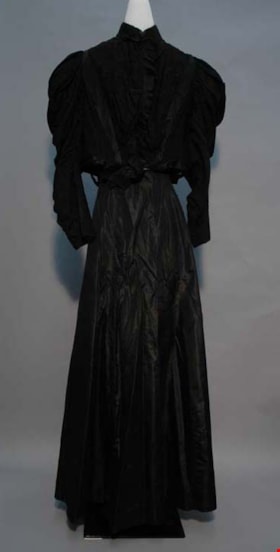
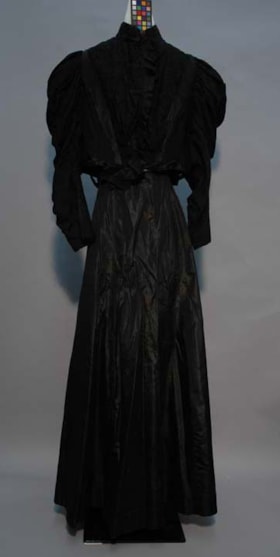
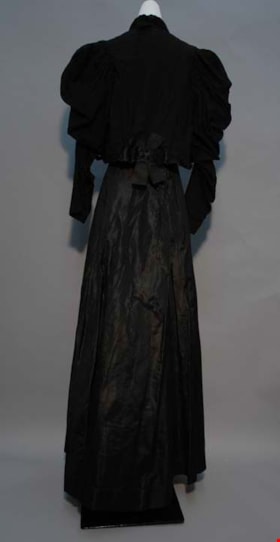
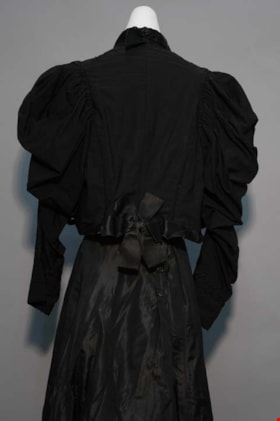
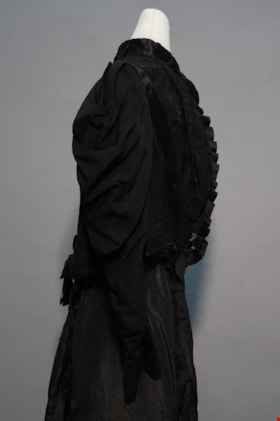
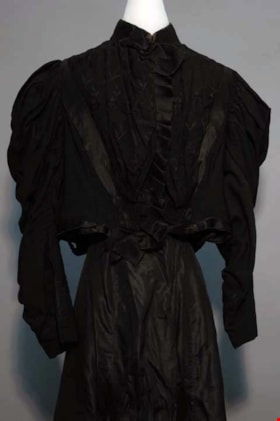
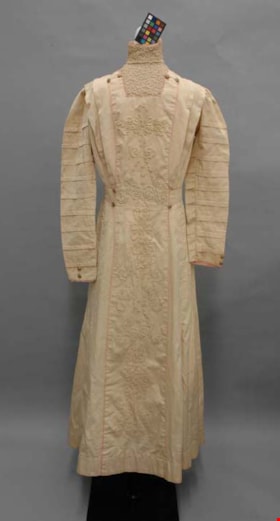
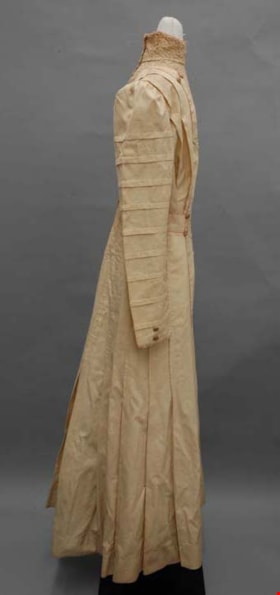
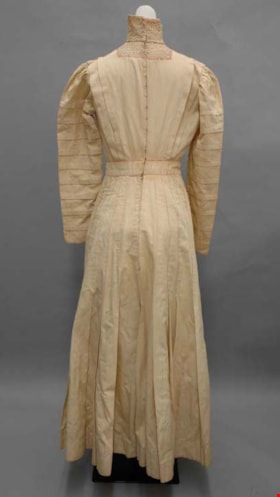
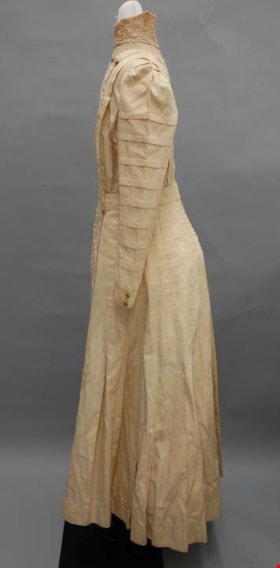
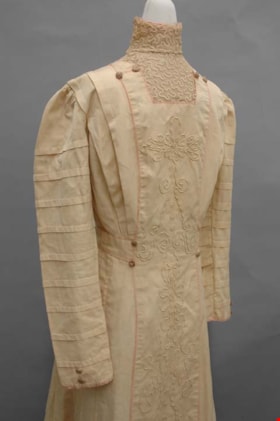
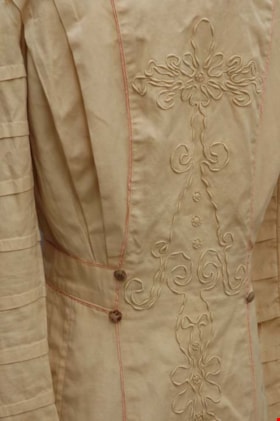
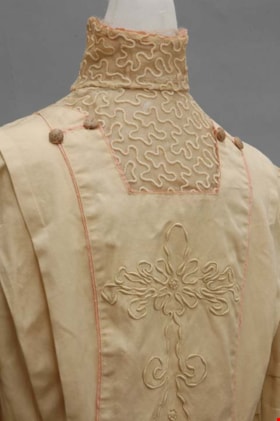
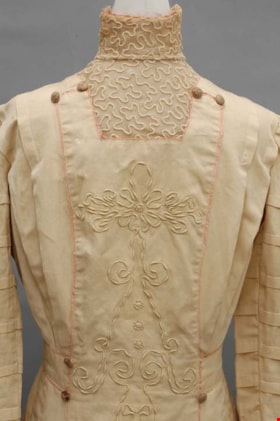
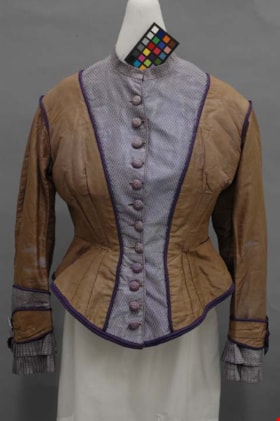
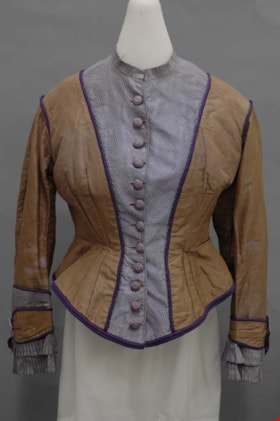
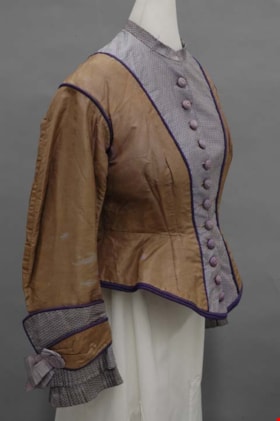
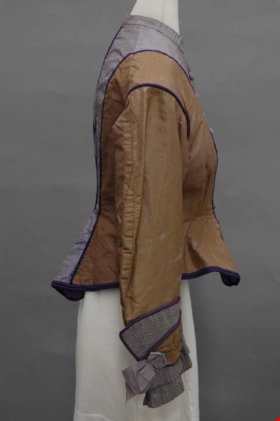
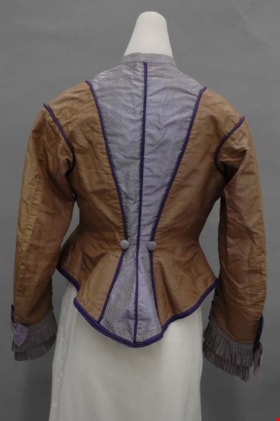
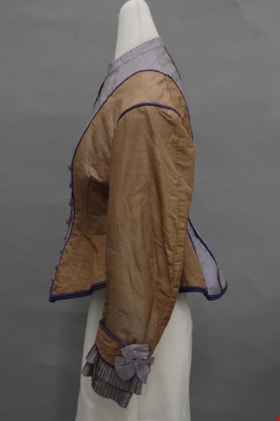
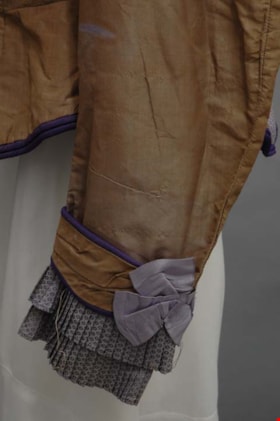
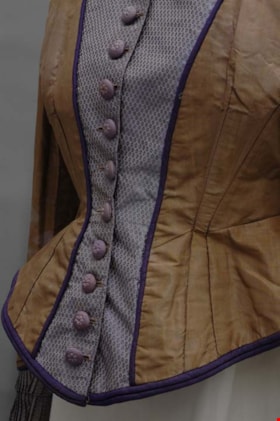
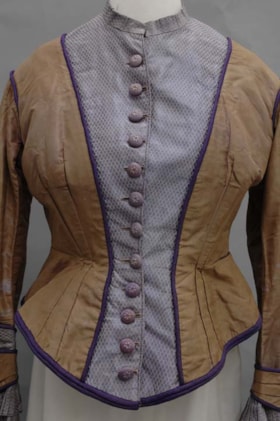

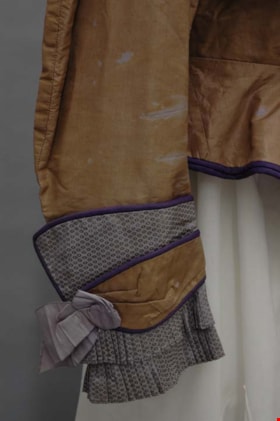
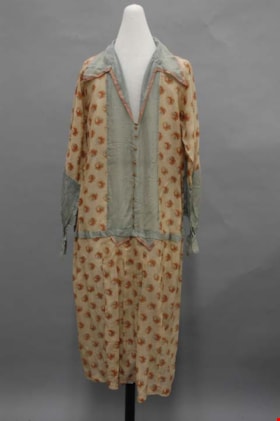
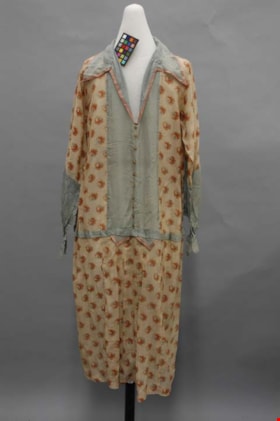
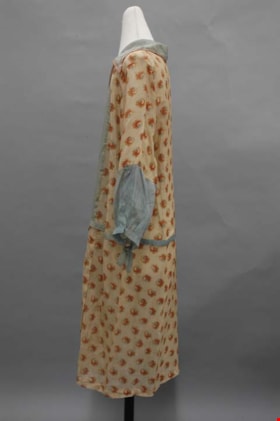
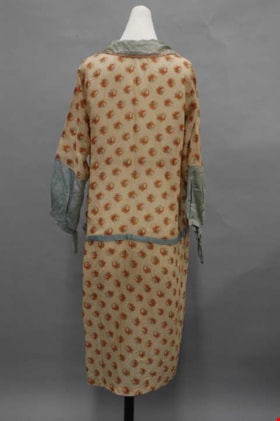
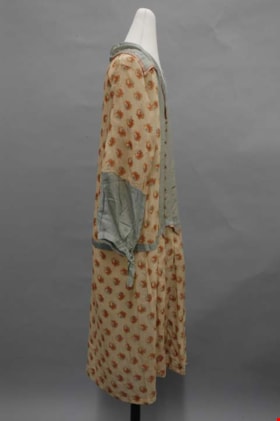
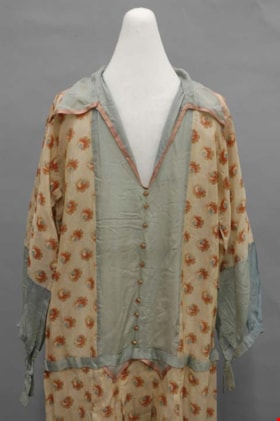
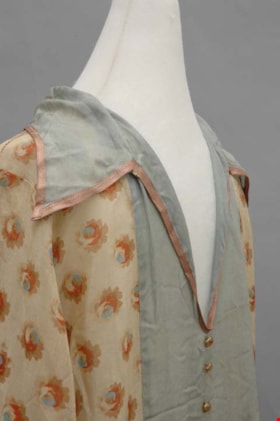
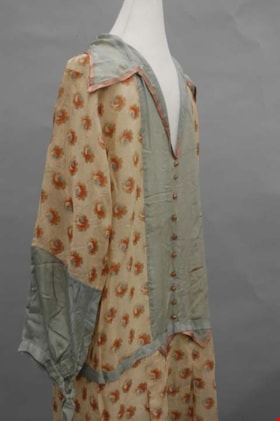
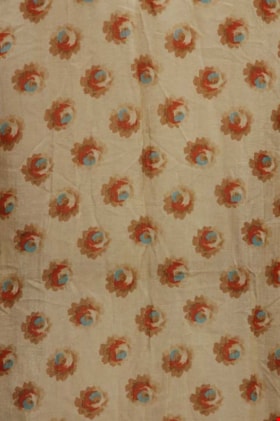
.jpg?width=280)
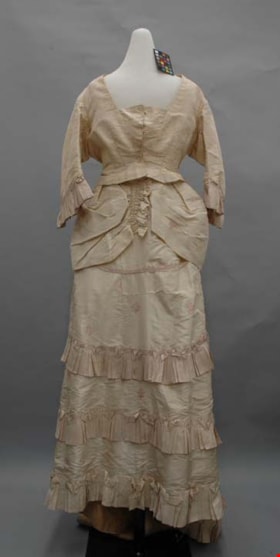
.jpg?width=280)
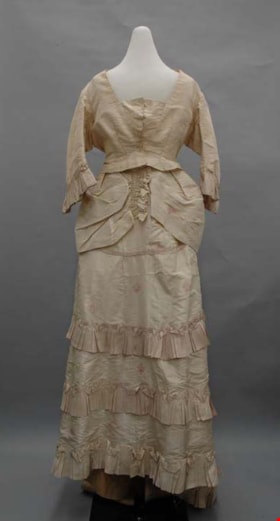
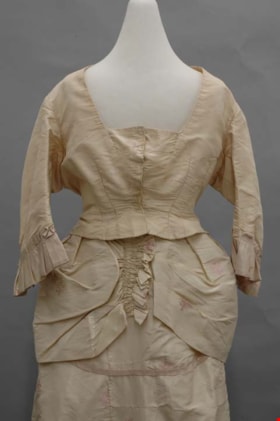
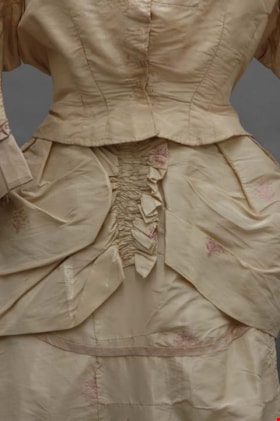
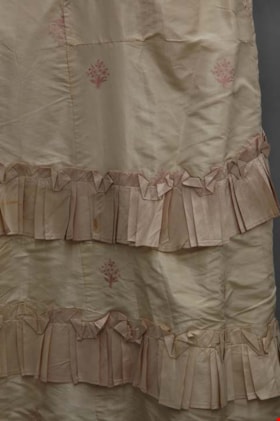
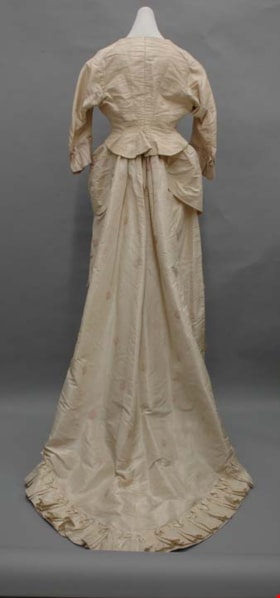
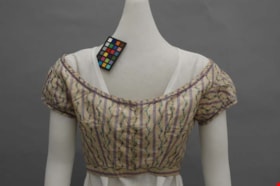
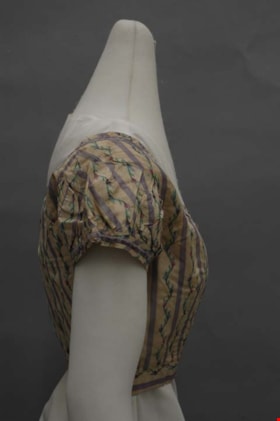
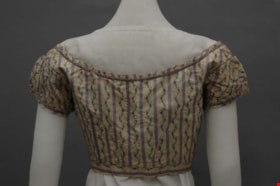
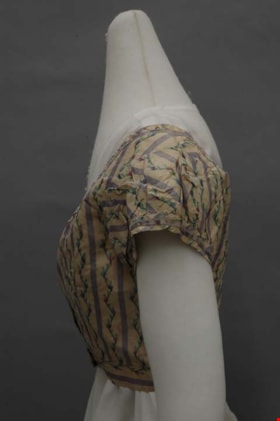
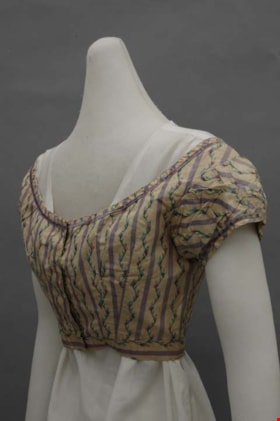
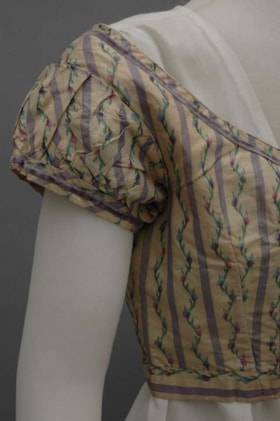
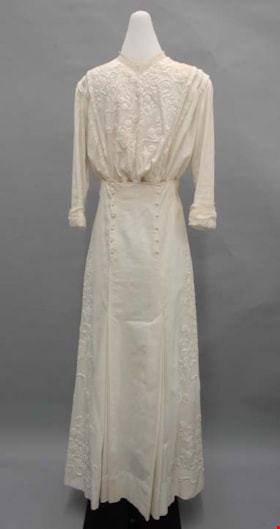
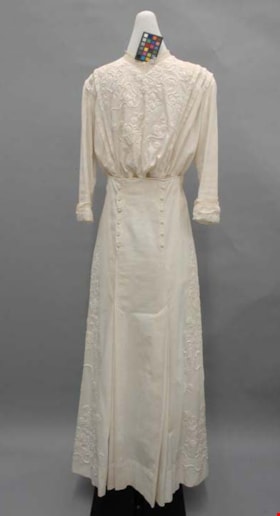
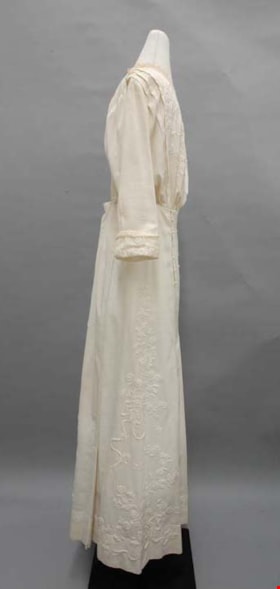
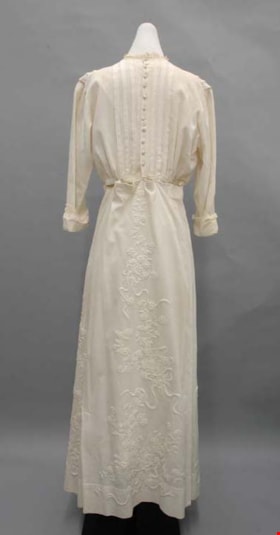
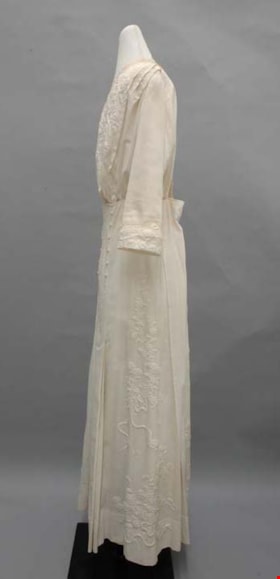
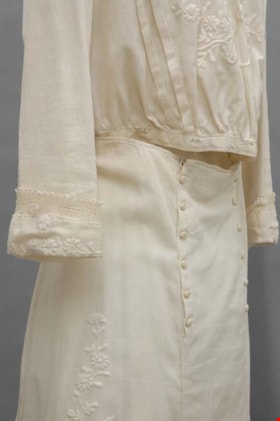
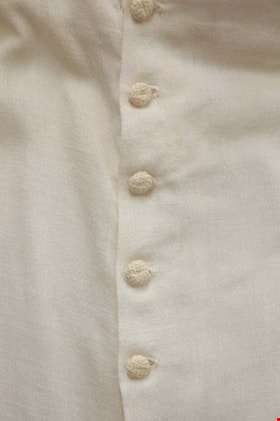
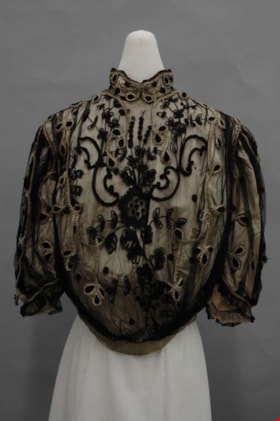
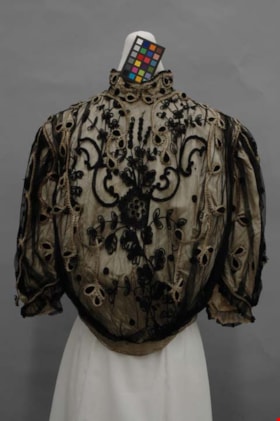
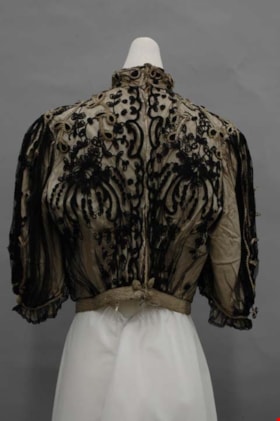
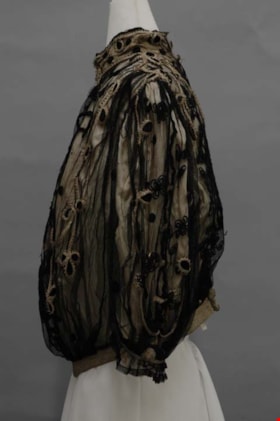
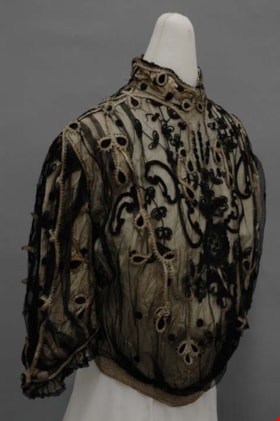
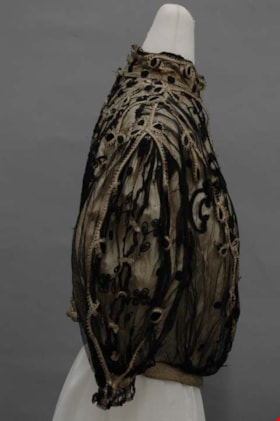
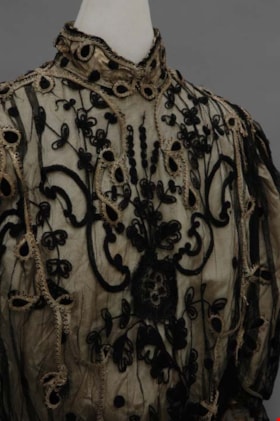
.jpg?width=280)
